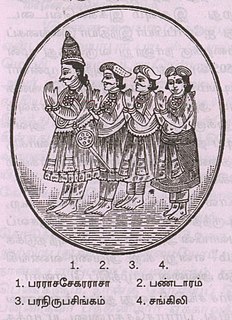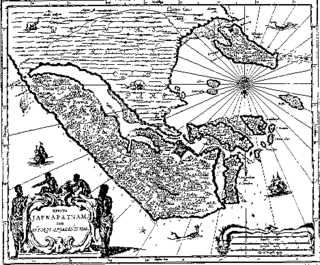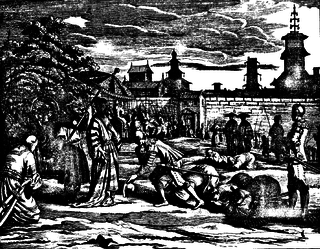| Pararacacekaran VII | |||||
|---|---|---|---|---|---|
| King of Jaffna | |||||
Second from the left is Puviraja Pandaram | |||||
| Reign | 1561–1565 1582–1591 | ||||
| Predecessor | Cankili I (Cekaracacekaran VII) Periyapillai (Cekaracacekaran VIII) | ||||
| Successor | Periyapillai (Cekaracacekaran VIII) Ethirimana Cinkam (Pararacacekaran VIII) | ||||
| Died | 1591 | ||||
| Issue | Ethirimana Cinkam (Pararacacekaran VIII) | ||||
| |||||
| Tamil | புவிராஜ பண்டாரம் | ||||
| House | Aryacakravarti dynasty | ||||
| Father | Cankili I (Cekaracacekaran VII) | ||||
Puviraja Pandaram (Tamil : புவிராஜ பண்டாரம்) (died 1591) ruled the Jaffna kingdom during a period of chaos during and after the death of his father Cankili I in 1565. He became king in 1561 following a local uprising against Cankili I. Although he was the nominal king, Cankili I wielded real power behind the throne until his death in 1565. After Cankili's death, Puviraja Pandaram lost power to one Kasi Nainar and Periyapillai. After the death or abdication of Periyapillai in 1582, Puviraja Pandarm was nominated as the king for the second time. [1] [2]

Tamil is a Dravidian language predominantly spoken by the Tamil people of India and Sri Lanka, and by the Tamil diaspora, Sri Lankan Moors, Douglas, and Chindians. Tamil is an official language of two countries: Sri Lanka and Singapore and official language of the Indian state Tamil Nadu. It has official status in the Indian state of Tamil Nadu and the Indian Union Territory of Puducherry. It is used as one of the languages of education in Malaysia, along with English, Malay and Mandarin. Tamil is spoken by significant minorities in the four other South Indian states of Kerala, Karnataka, Andhra Pradesh and Telangana and the Union Territory of the Andaman and Nicobar Islands. It is one of the 22 scheduled languages of India.

Cankili I, also known as Segarasasekaram, is the most remembered Jaffna kingdom king in the Sri Lankan Tamil history. He was very active in resisting Portuguese colonial inroads into Sri Lanka. He also inherited his throne via palace intrigues in which number of heir apparent’s died under mysterious circumstances. At the end, he was removed from power by a local uprising that led to his son Puviraja Pandaram taking nominal power from him.
Kasi Nayinar Pararacacekaran was of one of the Aryacakravarti rulers of Jaffna kingdom who followed in the chaotic period after the death of Cankili I(1519–1561), and he removed Puviraja Pandaram. He was not from royal family, which made despite against him, and his enemies approached Portuguese, who ruled from Mannar. Portuguese utilized this opportunity and fought with Kasi Nayinar, and he was imprisoned. Portuguese appointed a king, and later he became victim to the supporters of Kasi Nayinar. After he rescued, again he ruled Jaffna and soon he poisoned by his servant with the support of Portuguese.
During his second tenure he attempted to wrest the control of the pearl-rich Mannar Island from the Portuguese by attacking the fort by sea and land. He was defeated in both attempts. [2]

A pearl is a hard glistening object produced within the soft tissue of a living shelled mollusk or another animal, such as a conulariid. Just like the shell of a mollusk, a pearl is composed of calcium carbonate in minute crystalline form, which has been deposited in concentric layers. The ideal pearl is perfectly round and smooth, but many other shapes, known as baroque pearls, can occur. The finest quality natural pearls have been highly valued as gemstones and objects of beauty for many centuries. Because of this, pearl has become a metaphor for something rare, fine, admirable and valuable.

Mannar Island formerly spelt Manar Island, is part of Mannar District, Sri Lanka. It is linked to the main island of Sri Lanka by a causeway. It has an area of about 50 square kilometres, mainly covered with vegetation and sand. Adam's Bridge, is a chain of limestone shoals, between Pamban Island, also known as Rameswaram Island, off the southeastern coast of Tamil Nadu, India, and Mannar Island, off the northwestern coast of Sri Lanka. Geological evidence suggests that this bridge is a former land connection between India and Sri Lanka.
After the occupation of Kandy by Rajasinha I of Sitawaka, Puviraja Pandaram gave refuge and protection to the sole surviving member of the Kandyan Royal family, the infant, Princess Kusumasana, who was baptized, as Dona Catherina (The daughter of Karaliedde Bandara). [3]

Rajasinghe I was a king of the Kingdom of Sitawaka. He is known for his extreme bravery and patriotism. Born as Tikiri Bandara to King Mayadunne of the Kingdom of Sitawaka, the name "Rajasinha" was given to him after a fierce battle against Portuguese forces. Rajasinha means the King of Lions.
Eventually Puviraja Pandaram was captured and beheaded by Portuguese [4] in a battle during the second Portuguese expedition against Jaffna Kingdom led by André Furtado de Mendonça in 1591. He was succeeded by his son Ethirimana Cinkam. [2]

Portuguese invasion of Jaffna kingdom in 1591 AD was the second expedition against the Jaffna kingdom by the Portuguese. The campaign, led by Captain André Furtado de Mendonça, started from Mannar and continued to Nallur, the capital of the Jaffna kingdom. The Portuguese captured the kingdom, killed the king, and installed Ethirimana Cinkam as the new ruler.

André Furtado de Mendonça was a captain and governor of Portuguese India, and a military commander during Portuguese expansion into Ceylon, India, Indonesia and Malacca.
Ethirimanna Cinkam was the penultimate ruler of the Aryacakravarti line of Kings of the Jaffna Kingdom in northern Sri Lanka. He came to power due to the second Portuguese expedition led by André Furtado de Mendonça in 1591. In that expedition, the King of Jaffna, Puviraja Pandaram and the father of Ethirimnna Cinkam was killed.










